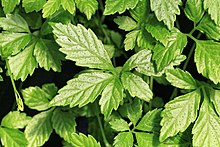| Gynostemma pentaphyllum | |
|---|---|

| |
| Scientific classification | |
| Kingdom: | Plantae |
| Clade: | Tracheophytes |
| Clade: | Angiosperms |
| Clade: | Eudicots |
| Clade: | Rosids |
| Order: | Cucurbitales |
| Family: | Cucurbitaceae |
| Genus: | Gynostemma |
| Species: | G. pentaphyllum |
| Binomial name | |
| Gynostemma pentaphyllum (Thunb.) Makino 1902 | |


Gynostemma pentaphyllum, also called jiaogulan (Chinese: 绞股蓝; pinyin: jiǎogǔlán; lit. 'twisting blue plant'), is a dioecious, herbaceous climbing vine of the family Cucurbitaceae (cucumber or gourd family) widely distributed in South and East Asia as well as New Guinea.
Jiaogulan is used to make a sweet tea and is applied in Chinese traditional medicine.
Common names
Among many common names are five-leaf ginseng, poor man's ginseng, miracle grass, fairy herb, sweet tea vine, gospel herb, and southern ginseng.
Gynostemma pentaphyllum is known as jiaogulan (Chinese: 绞股蓝) in China.
Description
Jiaogulan belongs to the genus Gynostemma, in the family Cucurbitaceae, which includes cucumbers, gourds, and melons. Its fruit is a small purple inedible gourd. It is a climbing vine, attaching itself to supports using tendrils. The serrated leaflets commonly grow in groups of five (as in G. pentaphyllum) although some species can have groups of three or seven leaflets. The plant is dioecious, meaning each plant exists either as male or female. Therefore, if seeds are desired, both a male and female plant must be grown.
Jiaogulan grows avidly in the wild, is cultivated, and occurs naturalized in dry regions of the United States.
Taxonomy
The plant was first described in 1406 CE by Zhu Xiao, who presented a description and sketch in the book Materia Medica for Famine as a survival food rather than a herb. The earliest record of jiaogulan's use comes from herbalist Li Shizhen's book Compendium of Materia Medica published in 1578, identifying jiaogulan supposedly for treating various ailments. While Li Shizhen had confused jiaogulan with an analogous herb, wulianmei, in 1848 Wu Qi-Jun rectified this confusion in Textual Investigation of Herbal Plants.
Phytochemicals
Modern recognition of the plant outside of China originated from research in sugar substitutes. Continued research has described several saponins (gypenosides) comparable or identical to those found in ginseng. Panax ginseng contains ginsenosides, while gypenoside saponins have been found in jiaogulan.
Other constituents include sterols and triterpenols. Gypenosides have been extracted from its leaves.
While there have been in vitro studies on toxicity, there have been no clinical trials providing high-quality clinical evidence about its efficacy and safety; no information exists about human toxicity.
Distribution and habitat
G. pentaphyllum is one of about 17 species in the genus Gynostemma, including nine species endemic to China. However, G. pentaphyllum has a wide distribution outside of China, ranging from India and Bangladesh to Southeast Asia to Japan and Korea as well as to New Guinea. In China, it grows in forests, thickets, and roadsides on mountain slopes at elevations of 300–3,200 m (980–10,500 ft) above sea level.
Jiaogulan is a vine hardy to USDA zone 8 in which it may grow as a short lived perennial plant. It can be grown as an annual in most temperate climates, in well-drained soil with full sun. It does not grow well in cold climates with temperatures below freezing.
Uses
The plant is used in folk medicine, typically as a herbal tea, but may be used as an alcohol extract or in dietary supplements. It has not seen widespread use in traditional Chinese medicine, being adopted only in the past 20 years, and grows mainly in Guizhou province.
In the European Union, jiaogulan is considered a novel food following a 2012 court ruling that prohibited its sale as food.
Research
Some limited research has assessed the potential for jiaogulan to affect such disorders as cardiovascular diseases, hyperlipidemia, or type 2 diabetes, but these studies were too preliminary to allow any conclusion that it was beneficial.
References
- ^ "Jiaogulan". Drugs.com. 26 October 2023. Retrieved 15 May 2024.
- ^ Shukun Chen & Charles Jeffrey. "Gynostemma Blume, Bijdr. 23. 1825". Flora of China. Missouri Botanical Garden, St. Louis, MO & Harvard University Herbaria, Cambridge, MA. Retrieved 2 May 2018.
- ^ Shukun Chen & Charles Jeffrey. "Gynostemma pentaphyllum (Thunberg) Makino, Bot. Mag. (Tokyo). 16: 179. 1902". Flora of China. Missouri Botanical Garden, St. Louis, MO & Harvard University Herbaria, Cambridge, MA. Retrieved 2 May 2018.
- Cheng JG, et al. (1990). "Investigation of the plant jiaogulan and its analogous herb, Wulianmei". Zhong Cao Yao. 21 (9): 424.
- "Jiaogulan ist als Lebensmittel in Deutschland und somit auch in der ganzen Europäischen Union nun offiziell verboten!" (PDF). www.jiaogulan-tee.net (in German). Retrieved 2016-04-27.
- Huyen VT, Phan DV, Thang P, Hoa NK, Ostenson CG (May 2010). "Antidiabetic effect of Gynostemma pentaphyllum tea in randomly assigned type 2 diabetic patients". Hormone and Metabolic Research. 42 (5): 353–7. doi:10.1055/s-0030-1248298. hdl:10616/40703. PMID 20213586. S2CID 11400222.
| Taxon identifiers | |
|---|---|
| Gynostemma pentaphyllum |
|